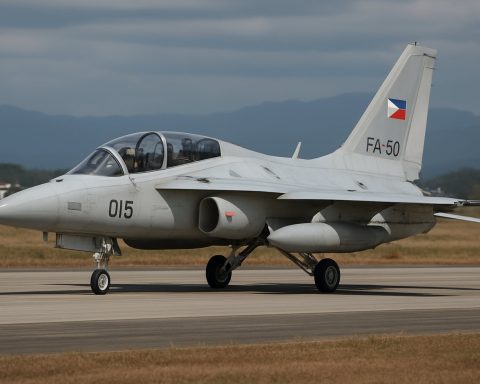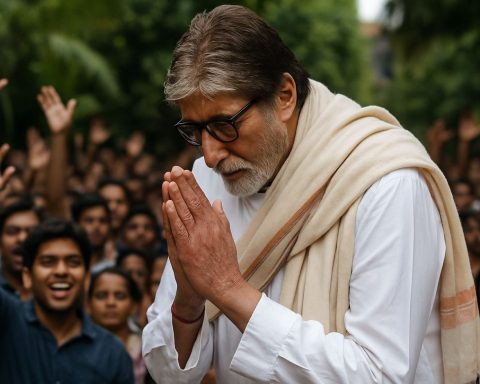- The U.S. has silently deployed six B-2 stealth bombers to Diego Garcia, marking a significant military presence in the Indian Ocean.
- This deployment consists of 30% of the global fleet of B-2s, signaling a notable power projection by the U.S. military.
- The U.S. has increased its aircraft carrier presence in the Indo-Pacific, with three carriers strategically positioned in key regions.
- The military activity is linked to growing tensions in the Middle East, focusing on threats from Iran-supported groups like the Houthis in Yemen.
- The move reflects a multi-layered strategy of deterrence and diplomacy, emphasizing vigilance as a means of maintaining global stability.
While global attention danced around the political maneuvers of tariffs and trade wars, the United States orchestrated a silent and substantial military deployment in the heart of the Indian Ocean. The pristine blue waters surrounding Diego Garcia, a remote island nestled in the vast Indian Ocean, have become the temporary home to six B-2 stealth bombers, the jewel in the crown of America’s aerial supremacy. This strategic deployment marks one of the most significant power projections by the U.S. military in recent history.
These sleek, black silhouettes of B-2 bombers rest along the runway, their very shape designed to slip unseen through the skies. Housing 30% of the global fleet of these stealth aircraft, this move raises eyebrows and questions in equal measure. With the U.S. boasting just 20 of these high-tech marvels, their relocation to Diego Garcia conveys a message louder than any diplomatic communiqué.
But the B-2 bombers aren’t alone in this military ballet. The U.S. has heralded an increase in its aircraft carrier presence across the Indo-Pacific, a region dense with geopolitical tension. Three carriers now navigate these waters, each a fortress of iron and strategy. As the USS Carl Vinson heads towards the Middle East, the USS Harry S. Truman holds its ground in the Arabian Sea, while the USS Nimitz steams toward the strategic corridors of the South China Sea.
To an observer of world affairs, the signals are clear yet complex. The U.S. states this influx is to bolster defense postures, to stand ready against any threat—state or non-state—that dares to disturb the regional balance. A strategic posture of power projection designed to maintain equilibrium—or perhaps tip it in favor of Washington.
Behind the scenes, whispered speculations link this formidable presence to the destabilizing currents sweeping through the Middle East. The Houthis in Yemen, a faction long supported by Iran, have been an increasing focus of American military action. The ongoing tension, alongside Iran’s nuclear ambitions and its alliance with Hamas, keeps defense analysts on alert.
The scale of this deployment surpasses a mere response to asymmetric warfare from non-state actors. It resonates as a symphonic caution, echoing through adversaries’ corridors, particularly directed at Tehran’s hardened resolve. President Trump, with his well-documented rhetoric, has hinted at a preference for negotiation over conflict, yet his actions resonate with readiness; readiness for consequences should dialogue fail to bear fruit.
Through this lens, the U.S. move is not merely a defensive posture but a multi-layered strategy that combines deterrence with diplomacy. The rising shadows of these bombers on sandy atolls echo a complex narrative of power, with America drawing bold lines across the geopolitical map. As the world watches, the takeaway is clear: vigilance remains the keystone of modern peace, where necessity orchestrates the presence of might in the service of stability.
The Strategic Implications of U.S. Military Deployment in the Indian Ocean
Understanding the Military Strategy Behind U.S. Deployments
The U.S. deployment of six B-2 stealth bombers to Diego Garcia and increased naval presence in the Indo-Pacific marks a significant military maneuver that reverberates through global geopolitical dynamics. Below are additional insights and analysis surrounding this strategic shift, addressing various aspects from geopolitical implications to technological advantages.
Geopolitical Context and Implications
1. Signal of Strength: The deployment serves as a deterrent, signaling U.S. commitment to maintaining regional stability, particularly in areas with rising tensions like the South China Sea and the Middle East. It underscores the U.S. strategy of power projection to reassure allies and warn adversaries.
2. Deterrence Against State and Non-State Actors: With Iran and its alliances under scrutiny, the U.S. aims to counterbalance threats from both state actors like Iran and non-state actors such as the Houthis. This also indirectly pressures nations supporting destabilizing elements.
3. Impact on U.S.-China Relations: The presence in the Indo-Pacific may heighten U.S.-China tensions. The South China Sea is a contentious area, and continued U.S. military presence might be perceived as a challenge to China’s territorial claims and strategic interests.
4. Regional Alliance Assurance: The deployment reassures U.S. allies, such as Japan, South Korea, and Australia, of its commitment to defend mutual interests, fostering stronger alliances in a region experiencing growing Chinese influence.
Technological and Strategic Advantages of B-2 Bombers
1. Stealth Capabilities: The B-2 Spirit is renowned for its radar-evading design, capable of penetrating sophisticated anti-aircraft defenses, securing an unquestionable strategic advantage.
2. Range and Payload Flexibility: With a range that allows it to strike targets anywhere in the world and a payload versatility that can accommodate various munitions, the B-2 enhances the U.S. deterrence posture.
3. Role in Joint Operations: The bombers allow for integrated operations with carriers and other military assets, providing flexible, responsive options for crisis response or preemptive action.
Current Trends and Future Developments
1. Modernization and Sustainability: The U.S. military is investing in modernizing its existing bomber fleet to include new technologies that enhance capabilities while ensuring sustainable, energy-efficient operations.
2. Future Deployments: As geopolitical tensions fluctuate, the U.S. might recalibrate its deployments according to developments, particularly concerning Iran’s nuclear strategy and maritime disputes in the Indo-Pacific.
3. Industry Insights: Defense contractors, including Northrop Grumman, continue advancing aerospace technologies, potentially leading to next-generation bombers with enhanced stealth and capabilities.
Practical Recommendations for Readers
– Stay Informed: Engage with credible news sources and strategic analysis platforms to monitor developments in military deployments and geopolitical shifts.
– Understand Defense Postures: Recognize the strategic importance of military deployments in global diplomacy and security, helping contextualize news in a broader scope.
Conclusion
The U.S. military’s increased presence in the Indian Ocean through advanced bombers and naval power represents a calculated strategy to uphold international security and balance within a complex global landscape. By comprehending these movements, one gains a deeper understanding of modern military strategy, where power projection serves both deterrence and diplomacy.
For further insights into military strategies and geopolitical analysis, visit Global Times or Defense News.







